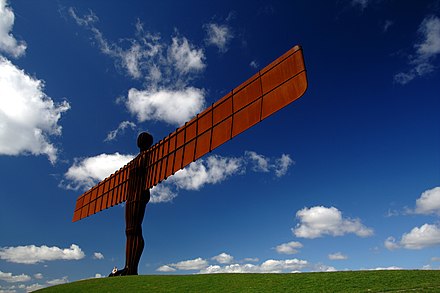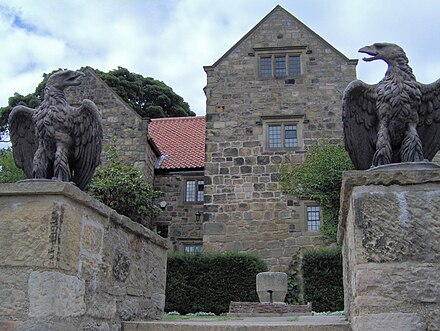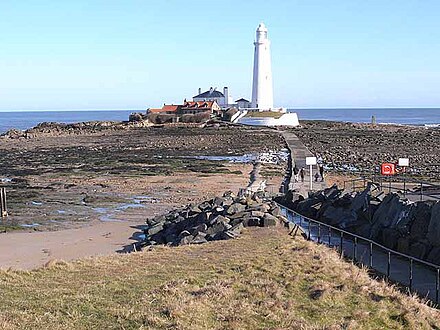Tyne and Wear - county in England
Tyne and Wear is a county and metropolis in the North East of England, created in 1974 from towns that had been in Northumberland or County Durham, plus Newcastle upon Tyne. The area is industrial but has a rich heritage, some surprisingly attractive cityscapes, and a lively entertainment scene. In 2019 the population was 1,136,371.
Cities and towns
- Newcastle upon Tyne is the buzzing city hub.
- Gateshead south bank of the Tyne is a separate city.
- South Tyneside consists of South Shields, Jarrow, Boldon and Hebburn
- Sunderland was home to the Venerable Bede and made glass even in his day.
- Washington has the ancestral home of George Washington's family.
- Wallsend is where Hadrian's Wall began.
- Tynemouth has a ruined priory and castle, and beach strip.
- Whitley Bay is a small beach resort.
Other destinations
- Hadrian's Wall 📍 is obliterated beneath Newcastle but re-emerges to the west at Heddon. It's mostly just a ditch until Hexham further west, then the best parts march over the hills to Haltwhistle.
Understand
This area was industrial even in the 13th century, through coal-mining, salt-panning, glass-blowing and quarrying. Newcastle grabbed a monopoly on coal and became a county in its own right in 1400, while the other settlements were villages or small towns each around their own coal pits and wharves on the rivers Tyne or Wear. North of the Tyne (except Newcastle) was the county of Northumberland, and south was County Durham. The population grew rapidly from the 19th century when deep mining reached lucrative seams, railways and steam power arrived, and the riverbanks rang with the hammers of shipbuilders. The towns grew into a single sprawling conurbation, with a mix of urban squalour and confident Georgian and Victorian civic architecture.
The historic counties became unbalanced between their metal-bashing towns at one end and farms and hills at the other. In 1974 the metropolis of Tyne and Wear was created, with Newcastle at its core, North Tyneside taken from Northumberland, and Gateshead, South Tyneside, Sunderland and Washington taken from County Durham. The new entity has stood the test of time and is approaching its 50th birthday. The towns are commuter-belt for Newcastle but have retained their own industry, transport hubs and identity.
Many visitors flash through Durham and Northumberland to reach Scotland, and the only reason they linger here is through being stuck in traffic on the A1 near Metrocentre. They could do worse than turn off and explore: it's not pretty-pretty scenic but is rich in industrial heritage, and in the cultural wealth built on that foundation.
The climate is cool in summer and mild in winter, and Newcastle is a year-round resort. The rainfall is somewhat less than the UK average, with little seasonal variation.
Get in
By plane
Newcastle Airport 📍 (IATA: NCL) is 6 miles northwest of Newcastle and served by the Metro. There are flights from London Heathrow, Amsterdam, Paris CDG, Dublin, other European and Med cities and Dubai. Domestic flights also connect Exeter, Southampton, Belfast and Aberdeen.
Manchester Airport (IATA: MAN) has many long-haul flights and is just over 3 hours to Newcastle by train.
Durham Tees Valley Airport (IATA: MME) near Darlington has very few flights and is ill-served by public transport.
By train
Wikivoyage has a guide to Rail travel in Great Britain
Newcastle has frequent trains from London Kings Cross, taking 3 hours via Peterborough, York, Darlington and Durham, and continuing north to Berwick-upon-Tweed, Edinburgh, Glasgow and Aberdeen. Trains also run hourly from Bristol and the southwest via Birmingham, Sheffield, Leeds and York, from Liverpool via Manchester, Leeds and York, and from Carlisle via Hexham and continuing to Sunderland and Middlesbrough.
Sunderland has five direct trains from London, otherwise change at York.
For the other towns change at Newcastle for the Metro. Washington has neither mainline nor Metro trains, change at Newcastle for the bus.
By bus
 Buses by National Express and Megabus take 7 hours from London Victoria to Sunderland and Newcastle. There are also buses to Newcastle from London via Heathrow airport and the Midlands, from Liverpool via Manchester and Leeds, and from Glasgow via Edinburgh.
Buses by National Express and Megabus take 7 hours from London Victoria to Sunderland and Newcastle. There are also buses to Newcastle from London via Heathrow airport and the Midlands, from Liverpool via Manchester and Leeds, and from Glasgow via Edinburgh.
Regional buses ply from Durham, from Carlisle via Hexham, and from Berwick-upon-Tweed via Alnwick and Morpeth.
By road
The main north-south route divides around the cities like a county-sized traffic island. For most destinations, including Newcastle, Gateshead and Washington, stay on A1(M) (which sweeps to the west) until the relevant turn-off. For Sunderland, South Tyneside and the north Tyneside towns, take A19 which bypasses to the east and goes through the Tyne Tunnel (toll).
From Glasgow or Stranraer (for ferries from Ireland) head for Carlisle then follow A69 east - this road climbs no great hills and is rarely closed by winter weather. From Manchester cross the Pennines on M62 to join M1 / A1(M) north.
By boat
An overnight DFDS ferry sails from IJmuiden near Amsterdam to North Shields on the north bank of the Tyne.
Get around
For public transport information in Tyne and Wear, see the transport authority's journey planner.
Some transport services in Tyne and Wear have changed due to Covid-19. See Coronavirus updates from Nexus for more details. Facemasks are required on the Metro.
By metro
Tyne & Wear Metro is quick and inexpensive, and is the best option between the area's towns. There are two lines, mostly overground: Green Line runs from Newcastle Airport to South Gosforth, Newcastle city centre, Gateshead, Heworth, Sunderland and South Hylton. Yellow Line makes a great loop north from St James in Newcastle city centre to Wallsend, North Shields, Tynemouth, Whitley Bay then South Gosforth, back through city centre (crossing itself at Monument) then Gateshead, Heworth, Jarrow and North Shields. So for the north bank of Tyne always take the anti-clockwise loop, but for Whitley Bay you could go either way.

Trains run between 06:00 and 23:00, normally every 6-10 min but in 2021 / 22 this is scaled back to 12-15 min. There are three fare zones: a single for one is £2.10, two zones £3, all zones (eg from the airport) £3.70. A day-ticket for one zone is £3.30, for two is £4.40 and for all is £5.40. Plusbus tickets are not valid on the Metro.
Ticket machines take cards or cash. Main stations have ticket barriers. Outlying stations may have no gates or leave them open at quiet times, but ticket inspectors patrol and are wearily familiar with lame excuses by fare dodgers. Smoking is banned on the entire system, including open-air stations.
By bus
 Tyne and Wear has an extensive network, and for some areas such as Washington it's the only public transport. Fares are the same as the Metro but bus is slower, eg Newcastle to Tynemouth is an hour by bus and 30 min by Metro.
Tyne and Wear has an extensive network, and for some areas such as Washington it's the only public transport. Fares are the same as the Metro but bus is slower, eg Newcastle to Tynemouth is an hour by bus and 30 min by Metro.
Most routes across the region are by Go North East:
- Bus 1 every 20 min from Gateshead to Newcastle, Wallsend, North Shields, Tynemouth and Whitley Bay.
- X1 every 15 min from Newcastle to Gateshead, Washington and Peterlee.
- Bus 2 and 8 every 30 min between Sunderland and Washington.
- Bus 9 every 30 min between Jarrow and Sunderland.
- Bus 20 every 15 min from Durham to Sunderland and South Shields.
- Bus 21 every 30 min from Durham to Chester-le-Street, Angel of the North, Gateshead and Newcastle
- X22 between Gateshead and Metrocentre.
- Bus 27 every 15 min from Newcastle to Gateshead, Heworth, Jarrow and South Shields.
- Bus 50 every 30 min from South Shields to Washington, Chester-le-Street and Durham.
 Routes to the north are by Arriva:
Routes to the north are by Arriva: - X8 every 30 min from Newcastle to Gosforth, Cramlington and Blyth.
- X12 hourly from Durham to Newcastle.
- Bus 43 hourly from Newcastle to Gosforth, Cramlington and Morpeth.
- Bus 51 hourly from Newcastle to Wallsend and Whitley Bay.
Stagecoach have short town routes, but also:
- Bus 10 every 30 min from Hexham to Corbridge, Prudhoe, Blaydon, Metrocentre, Gateshead and Newcastle.
- X24 every 30 min between Sunderland, Gateshead and Newcastle.
Day tickets are only valid for individual operators.
By boat
The Tyne ferry plies between North and South Shields, taking foot passengers and bicycles. There are also foot- and cycle tunnels next to the A19 tunnel, which is only for vehicles.
See

- The Angel of the North spreads their massive wings by the A1(M) as you approach from the south.
- Newcastle has an elegant late-Georgian city centre around Grey St and Grainger Town.
- Gateshead: the south bank of the Tyne facing Newcastle is a separate city. Walk across the Millennium or "Blinking" Bridge for the Baltic Art Gallery. You might detour to come back via the High Level Bridge or the Swing Bridge.
- Roman Britain: South Tyneside has the depot fort of Arbeia, and Wallsend has the fort of Segedunum at Mile Zero of Hadrian's Wall. The Great North Museum in Newcastle shows artefacts from that era, but the wall route is obliterated beneath the city. You have to go 20 or more miles west into Northumberland to reach the scenic and better-preserved stretches.
- Old churches: Jarrow has Bede's monastery, and Tynemouth has a medieval priory by the castle. Others are Victorian or later to serve the growing cities, but the 13th century Black Friars in Newcastle is now a restaurant.
- Lighthouses: St Mary's is on a tidal islet north of Whitley Bay, Souter is on the breezy headland south of South Shields. Others are simple navigation lights, but look out for those of Fish Quay in North Shields, and the spooky Herd Groyne in South Shields. Or else! - you'll be on the rocks otherwise.
- Watch Brigades are a northeast oddity, though they were once nationwide. Founded from the 1860s, they're coastal volunteers: they don't launch lifeboats, but assist the Coastguard with shore-based rescue. Only three brigades remain active, in Sunderland, South Shields and Tynemouth, and their watch-houses display local maritime history.
Do
- Watch football: Newcastle United and Sunderland AFC are the pro soccer teams, Newcastle Falcons play pro rugby union (15 a side) and Newcastle Thunder play rugby league (13 a side).
- Cricket: Durham County Cricket Club play at Riverside in Chester-le-Street; Test matches (ie internationals) are also played there.
- Go to the races but don't head for Blaydon Races, which closed over a century ago. Newcastle Racecourse is in the northern suburb of Gosforth, with meetings year-round.
Eat
- Newcastle Chinatown, along Stowell St, also has Japanese and "fusion" cuisine whatever that is.
- Blackfriars within a 13th century monastery in Newcastle is probably the region's top restaurant.
- All the towns have a cheap and cheerful strip with Italian and the fast-food of several continents.
- A stottie is a circular loaf of bread. For a lunchtime bite have a half or quarter-stottie filled with ham, cheese or the like.
- Pease Pudding is what you get if you order what looks like remarkably cheap guacamole. It's a mush of split peas.
Drink
- There are nowadays no large commercial breweries in the northeast, but Newcastle has a dozen small independents and Gateshead has three. Vaux still have a taproom in Sunderland but no production there.
- Newcastle Brown Ale is the city's signature drink, but it's now brewed in Tadcaster, North Yorkshire.
- The region's only distillery is Poetic Licence in Sunderland, making gin and vodka.
- Crossroads in Concord near Washington makes mead. Try it, but you won't want to stay on pints of it all evening.
Stay safe
 There are few natural hazards here, so it's just the obvious precautions around traffic, unruly drunks, and care of valuables.
There are few natural hazards here, so it's just the obvious precautions around traffic, unruly drunks, and care of valuables.
Go next
- West in Northumberland are the historic towns of Corbridge and Hexham, the best sections of Hadrian's Wall, and the scenic South Tyne valley.
- Cumbria is reached further west, with Carlisle and the north end of the Lake District.
- North is Alnwick castle, the rugged Northumberland coast, and the island of Lindisfarne.
- Beamish is an extensive open air museum 10 miles south of Gateshead.
- Durham is the charming old centre of County Durham.
England
Primary administrative division
